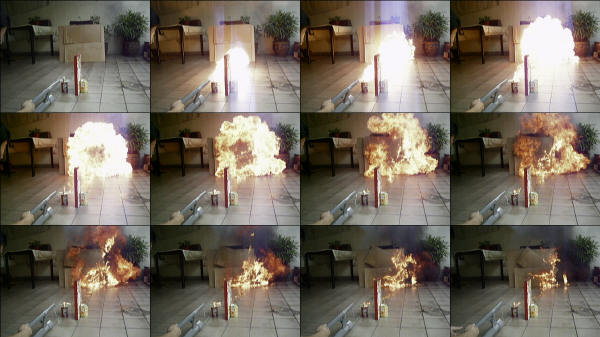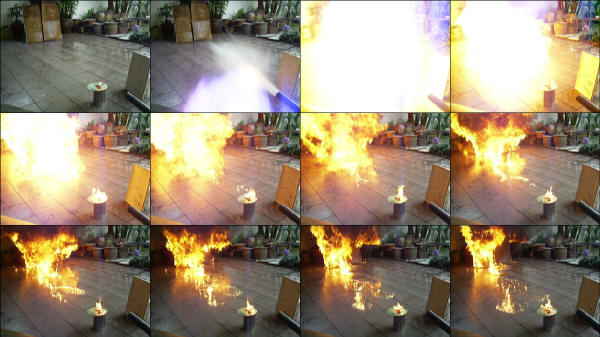Fire Cannon
Using AirCannon TFI and Kerosene/Thinner
17 Mar 2004
Introduction
Disclaimer: The project listed here is for educational purposes only. Do not try at home.
Fire is a wonderful phenomenon caused by an
oxidization of combustible fuel, and there are three main elements in a
self-sustaining fire - fuel, oxidizer (usually just oxygen in the air),
and heat. The absence of any of these will prevent the fire from
sustaining. Fire begins by subjecting the fuel to a small injection of
energy - this can be heat from another fire, a matchstick, or even an
electrical spark, causing an exothermic (heat released) chemical chain
reaction and creating fire! Fire has been very important, and it turns
out, beautiful to look at.
Everyone likes a big flame. This was why the Fire Cannon was made. Basically,
a flammable liquid (kerosene) is shot out at high muzzle velocities at a initial heat source (candle) from my pneumatic air gun, and a big fire ball is produced. The goals of this project are:
-
Create a large ball of fire
-
The fire will only be sustained in the air and extinguish just, or before reaching the ground
(whereby it might set fire to objects; not what
we want)
-
Be safe as possible
(in the relative sense)
-
Use cheap fuels like kerosene (paraffin oil) or thinner
My 1 inch PVC air cannon was utilized for this project.
Project Details

In my air cannon, I was using a standard ball valve as the 'trigger'. In order to
protect the valve from the kerosene and to effectively push the fuel out
of the barrel, a wad of wet tissue was stuffed down the barrel to the bottom. The wet tissue also pushes the kerosene completely out of the barrel, preventing any from going back down through the valve into the air chamber. It is important to note that only a little amount of kerosene should be used. The kerosene should come out of the barrel, get ignited by the candle, and deflagrate quickly and the fuel would be used up before the fire actually hits the ground. If too much was used, the kerosene will not be completely combusted and may cause a serious fire when it continues burning on the ground. Kerosene is not the ideal fuel to use as it does not burn cleanly. Another possible fuel would be alcohol. However,
kerosene it is cheap and readily available. The ideal amount of kerosene should be experimented with, with very little amounts starting from 10ml.
Fireballs
Setup
Some preparation should be done before firing. I am firing the shot in the yard. Note that kerosene does not burn cleanly
- that means a lot of black sooty smoke is produced and will soot up anything it gets in contact with. Due to a limited space, the cannon was fired at a target board some 2-3m away. I used some large pieces of cardboard which were soaked in water prior to firing. They were clipped to a chair. The candle was placed above a can, and a board was placed beside it to prevent the wind from blowing it out. Finally, the camera was placed on a chair behind the firing area.
Shot 1

Around 25ml of kerosene was used. Lets go through frame by frame...
-
Just before firing. The candle is lit (of course). Pressure in the tank is 25 psi.
-
The cannon is fired! The first part of the kerosene has combusted.
-
The fireball files towards the cardboard backing.
-
Almost all the kerosene has exited the barrel. The flame is extremely hot and bright.
-
The fire has hit the board is is beginning to spread out.
-
... spreading out into a 'O' shape.
-
... still spreading out... the cardboard is having a bad time.
-
The fire is clearly burning out and is much dimmer.
-
Most of the kerosene has burned off and a lot of black smoke is produced.
-
Some kerosene left at the bottom right hand corner of the boards. More black smoke
-
Note that the top board has fallen due to the wad of tissue paper hitting it.
-
Fire is almost completely gone, but a lot of smoke is produced.
Shot 2

For this shot, a generous amount 50-100ml of kerosene was used. This resulted in a HUGE fireball! The combustion was so great that a huge wave of heat blew me back and knocked over light plastic chair and a broom behind me! The flash was so bright it completely white-out the CCD of my camera (evident in the frame sequence above). A pressure of around 30psi was used. Needless to say it was totally awesome. The whole yard was filled with smoke after the shot.
-
Just before firing. The floor was wet due to a rain.
-
The cannon is fired! An interesting shot... you can see the kerosene coming out of the barrel.
-
HUGE combustion! Huge heat wave was created!
-
The huge fireball files towards board
-
The whole board is engulfed in flames
-
Note that the blast was so great that un combusted kerosene was forced back away from the board
-
Fire is less bright. More fire coming back
-
A 'mushroom' shaped cloud is formed. A LOT of black smoke.
-
Note that the top of the fire is totally black. Also note the fire on the floor.
-
... still burning...
-
There is still some kerosene left at the bottom left hand corner and is still burning
-
Fire is still burning. (at the board, and on the floor).
The board, and the floor was covered with soot after this shot.
-
Back to main page
(c) Gao Guangyan 2011
Contact: loneoceans [at] gmail [dot] com |

